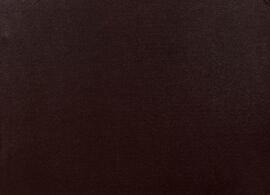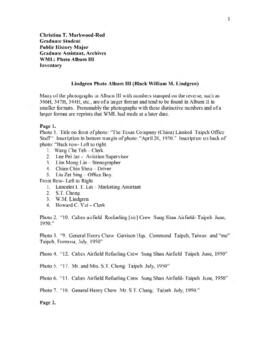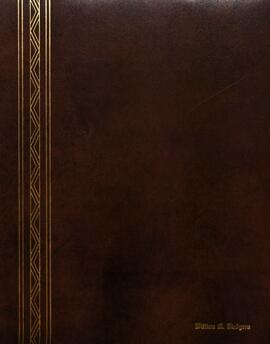Reference code
Name and location of repository
Level of description
Title
Date(s)
- 1920-1993 (Creation)
Extent
17.56 linear feet
Name of creator
Biographical history
World traveler William Marcellous Lindgren was born on September 26, 1922 to Roy and Rudy (Peterson) Lindgren in Braham, Minnesota, a small town just north of Cambridge on Highway 65. Lindgren was an only child.
In 1940, Lindgren entered the University of Minnesota, graduating in 1944 with a BA in Political Science and Economics. In early 1945, Lindgren joined the Royal Canadian Armed Forces and discharged in September 1945. After he was discharged, Lindgren enrolled at the University of British Columbia. He received his master's degree in Political Science and Economics in 1946.
With a connection through his University of Minnesota Sigma Nu fraternity, he was hired by the California Texas Oil Company (Caltex) in early 1947 and would arrive in Shanghai, China, in July of that year for training. In 1961, Lindgren left Caltex and was hired by Pfizer Pharmaceutical Company, then sent to Manila, Philippines. He resigned from Pfizer in 1964 and returned to the United States. Upon his return, Lindgren was hired in 1965 by St. Cloud State University to teach. In 1968, Lindgren resigned from St. Cloud State and was hired by R&D Products and then assigned to Hong Kong.
Lindgren resigned from R&D Products in 1974 and retired to Portugal, yet returned to Minnesota later that year permanently. In 1975, Lindgren was hired again by St. Cloud State to teach and held that position until he retired in 1988. After his 1988 retirement, Lindgren continued to travel extensively. In the spring of 1993, Lindgren learned he had terminal cancer and passed away on October 13, 1993 in Cambridge, Minnesota.
As an employee of Caltex, Lindgren began traveling across Asia in 1947. By the time he returned to Minnesota in 1966 after his stint with Caltex and Pfizer, he had been assigned to China, Taiwan, Hong Kong, India, Pakistan, Vietnam, Philippines, Singapore, and Japan. Whenever possible he would visit other nearby locales, including Macao, Thailand, Cambodia, Kashmir, Nepal, Tibet, and Afghanistan. Given the time frame and locations, Lindgren found himself in the middle of many events that changed the geo-political landscape of the 20th century, among them the establishment of Communist China, its invasion of Tibet and the Dalai Lama’s flight to India, the French-Viet Minh conflict and subsequent Vietnam War, and Cold War movements among the United States, the Soviet Union, and China in the border regions of Central Asia. This also made Lindgren a valuable source of information for American intelligence agencies, which often took advantage of his proximity and ability to move relatively freely in these areas by debriefing him for information.
Lindgren never married and had no children.
Scope and content
The William M. Lindgren Papers are organized by series. The bulk of the material are images, mostly slides, that date just after World War II until his death in October 1993.
Series 1: Personal Papers
Organized into three sub-series, these materials focus on many aspects of Lindgren's life. Materials related to his academic career as a student and St. Cloud State faculty member are here, including two lectures (with recordings), his master thesis from the University of British Columbia, and various certificates and diplomas.
There is significant biographical information here as well. His autobiography, done in 1993 before he passed away, is key and tells Lindgren's life story through his own words. Lindgren's passports are important as they document the places he traveled for almost 50 years.
In addition, there is some correspondence with pen pals (as well as his parents) from all over the world.
Series 2: Photo Albums
The photo albums document mostly Lindgren's travels for almost fifty years. The photo albums that date before 1970 are particularly important, as they show Lindgren's extensive travels throughout Asia, including China, India, and the Middle East. The early albums show Lindgren as a young man before, during, and just after World War II are significant as well, especially the album that focuses on a visit to Yellowstone Park in 1940-1941.
The photo albums after 1970 are primarily Lindgren traveling when he was semi-retired or retired. The albums also include images of family activities in Cambridge or other Minnesota locations.
The photo albums in boxes 3 through 6 each include an index of the images and the descriptions that Lindgren gave them and with some commentary. These descriptions were created by student Christina T. Markwood-Rod in the early 2000s. In addition, some of the photo albums have been scanned to provide easier access.
Series 3: Print Images and Negatives
Dating primarily from the 1970s through the early 1990s, this series includes both print images and negatives. These images focus on Lindgren's world travels.
Some print images in this series do have negatives and are kept together. The negatives were organized here as Lindgren had organized them. The description was taken from the negative/photo envelope, which were written by Lindgren or Markwood-Rod. Those negatives that did not have photographs with them were kept together as units. These negatives, especially those from the 1980s and early 1990s, are for some of the images in the photo albums in series 2.
Significant images include the portraits of Lindgren as a young man and as he aged over time, including his passport photos. There are images of his parents, Roy and Rudy Lindgren, as children, young adults, and as they aged, too.
Series 4: Slides
Sub-series 1: Slide Presentations
This sub-series contains color slides, as organized by Lindgren, of his travels while working, especially in Asia during the 1940s through the early 1960s. Many of the slides have descriptions written on them by Lindgren. Locations featured include China, Cambodia, Vietnam, Hong Kong, India, Afghanistan, Pakistan, and Macao (China).
These slides were used by Lindgren for presentations to his classes and for other events.
Sub-series 2: Other slides
This sub-series contains color slides and described as "unused", as opposed to the slides in sub-series 1. These slides were organized by location by Lindgren. The majority of slides have descriptions written on them by Lindgren, as well as lists that were on slide storage cases in Lindgren's hand. Dating from the 1950s through the 1960s, locations visited include Australia, England, France, Greece, Nepal, North America, Philippines, Portugal, Spain, and Switzerland.
All the slides from both sub-series have been digitized as lower resolution JPEG images and available in an instance of Omeka. Each folder in this series was created as a separate collection in Omeka. Also, each image has been given a unique image ID number, starting with "LGR".
Information was added into the description field for individual slides if there was any to add. That information came from what Lindgren wrote directly on the slide as well as anything that was on list from the slides storage box. These lists were only from Sub-series 2: Other Slides. When the writing was hard to read, we did the best we could to transcribe it and then added a question mark in brackets. Anything that was added by Archives' staff was always put into brackets, especially if the slide was not identified but the landmark was easily recognized.
System of arrangement
The papers are organized by series and, in some cases, sub-series within the series.
Series 1: Personal Papers
Sub-series 1: Academic and Scholarship
These records are organized alphabetically by folder title.
Sub-series 2: Biographical
These records are organized alphabetically by folder title.
Sub-series 3: Miscellaneous
These records are organized alphabetically by folder title.
Series 2: Photo Albums
These photo albums are organized roughly in chronological order. The albums were somewhat organized by size and how well they fit into oversize boxes.
Series 3: Print Images and Negatives
These images are organized by folder title. The images themselves were organized as how Lindgren kept them organized and there is some overlap. Identification was used by how Lindgren identified them as well as work done on the materials in the early 2000s by University Archives.
Series 4: Slides
Sub-series 1: Slide Presentations
These slides are organized by group. Lindgren created multiple slide shows and were stored as units in slide carriers to be used in a slide projector. Placed in protective slide preservers, the slides follow Lindgren's organization, including at the slide level.
Sub-series 2: Other slides
These slides are organized by folder title. Titled as "unused" slides, these slides were organized as Lindgren organized them, including at the slide level. Most contain the index that was with each box.
Records are located at 27A.1a-3f.
Conditions governing access
There are no access restrictions.
Physical access
Technical access
Conditions governing reproduction
Permission to publish, quote, and reproduce must be secured from the copyright holder.
Languages of the material
Scripts of the material
Language and script notes
Finding aids
Custodial history
Immediate source of acquisition
Gift
Appraisal, destruction and scheduling information
Accruals
Much of the material was donated in 1988 and then after Lindgren's death in October 1993, including his Asian art collection. Additional unidentified material was donated in 2004. In 2017, unidentified material loaned to the University Archives in 2004 was formally donated to St. Cloud State through Lindgren's personal representative John Zavada.
In September 2004, Joyce Blosberg donated material to this collection.
Existence and location of originals
Existence and location of copies
Related archival materials
Nearly all of the pieces of East Asian art reside in the Miller Center. A website was created in 2015 to help showcase this art collection at http://www.stcloudstate.edu/library/archives/resources/lindgren.aspx.
Related descriptions
Specialized notes
Alternative identifier(s)
Rules or conventions
Sources used
Archivist's note
Tom Steman properly processed this collection in May-June 2017. Thanks to Christina T. Markwood-Rod (who did some initial processing of this material in the early 2000s for her thesis work), Eric Hall, Krista Lewis, Christina Christianson, Sarah Bavelli, Kasey Solomon, and Andrew Romitti.













